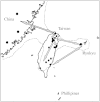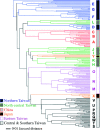Population genetic structure of Titanotrichum oldhamii (Gesneriaceae), a subtropical bulbiliferous plant with mixed sexual and asexual reproduction
- PMID: 14707003
- PMCID: PMC4241082
- DOI: 10.1093/aob/mch028
Population genetic structure of Titanotrichum oldhamii (Gesneriaceae), a subtropical bulbiliferous plant with mixed sexual and asexual reproduction
Abstract
Background and aims: Titanotrichum oldhamii is a monotypic genus distributed in Taiwan, adjacent regions of China and the Ryukyu Isands of Japan. Its conservation status is vulnerable as most populations are small and widely scattered. Titanotrichum has a mixed system of reproduction with vegetative bulbils and seeds. The aim of this study was to understand the population genetic structure of Titanotrichum in relation to its specific reproductive behaviour and to determine possible implications for conservation strategies.
Methods: After an extensive inventory of most wild populations of Titanotrichum in East Asia, samples from 25 populations within its major distribution were carried out utilizing RAPD and inter-SSR molecular fingerprinting analysis.
Key results: The findings support the conclusion that many populations reproduce predominantly asexually but that some genetic variation still exists within populations. However, significant amounts of variation exist between populations, perhaps reflecting population differentiation by drift. This partitioning of genetic diversity indicates that the level of inter-population gene exchange is extremely low. These findings are consistent with field observations of very limited seed production. The Chinese populations are similar to those of Northern Taiwan, while the Ryukyu populations fall within the range of variation of the north-central Taiwan populations. The Taiwanese populations are relatively variable and differentiation between north, east and south Taiwan is evident.
Conclusions: The distribution of Titanotrichum seems to be consistent with a former land connection between China, Taiwan and the Ryukyu Islands at a glacial maximum during the Quaternary, followed by progressive fragmentation of the populations. North-central Taiwan is the centre of genetic diversity, possibly due to the proximity of the former land bridge between the regions, together with the variety of suitable habitats in north Taiwan. The significance of these findings for conservation is discussed.
Figures



Similar articles
-
Meristem fate and bulbil formation in Titanotrichum (Gesneriaceae).Am J Bot. 2003 Dec;90(12):1696-707. doi: 10.3732/ajb.90.12.1696. Am J Bot. 2003. PMID: 21653346
-
Phylogeography of Quercus variabilis based on chloroplast DNA sequence in East Asia: multiple glacial refugia and Mainland-migrated island populations.PLoS One. 2012;7(10):e47268. doi: 10.1371/journal.pone.0047268. Epub 2012 Oct 24. PLoS One. 2012. PMID: 23115642 Free PMC article.
-
High levels of genetic diversity in island populations of the island endemic Suzukia luchuensis (Labiatae).Heredity (Edinb). 2003 Sep;91(3):300-6. doi: 10.1038/sj.hdy.6800311. Heredity (Edinb). 2003. PMID: 12939632
-
Chloroplast DNA phylogeography of Clintoniaudensis Trautv. & Mey. (Liliaceae) in East Asia.Mol Phylogenet Evol. 2010 May;55(2):721-32. doi: 10.1016/j.ympev.2010.02.010. Epub 2010 Feb 19. Mol Phylogenet Evol. 2010. PMID: 20172032 Review.
-
Plant molecular phylogeography in China and adjacent regions: Tracing the genetic imprints of Quaternary climate and environmental change in the world's most diverse temperate flora.Mol Phylogenet Evol. 2011 Apr;59(1):225-44. doi: 10.1016/j.ympev.2011.01.012. Epub 2011 Feb 1. Mol Phylogenet Evol. 2011. PMID: 21292014 Review.
Cited by
-
Population genetic structure of the endangered and endemic medicinal plant Commiphora wightii.Mol Biol Rep. 2010 Feb;37(2):847-54. doi: 10.1007/s11033-009-9661-9. Epub 2009 Aug 7. Mol Biol Rep. 2010. PMID: 19662516
-
Biotechnological approaches for conservation and improvement of rare and endangered plants of Saudi Arabia.Saudi J Biol Sci. 2012 Jan;19(1):1-11. doi: 10.1016/j.sjbs.2011.11.001. Epub 2011 Nov 28. Saudi J Biol Sci. 2012. PMID: 23961155 Free PMC article.
-
A leading-edge scenario in the phylogeography and evolutionary history of East Asian insular Taxus in Taiwan and the Philippines.Front Genet. 2024 May 2;15:1372309. doi: 10.3389/fgene.2024.1372309. eCollection 2024. Front Genet. 2024. PMID: 38756448 Free PMC article.
-
Life-history characteristics and historical factors are important to explain regional variation in reproductive traits and genetic diversity in perennial mosses.Ann Bot. 2023 Oct 4;132(1):29-42. doi: 10.1093/aob/mcad045. Ann Bot. 2023. PMID: 36928083 Free PMC article.
-
Population genetic structure of Monimopetalum chinense (Celastraceae), an endangered endemic species of eastern China.Ann Bot. 2005 Apr;95(5):773-7. doi: 10.1093/aob/mci087. Epub 2005 Feb 14. Ann Bot. 2005. PMID: 15710646 Free PMC article.
References
-
- AllnuttTR, Courtis JR, Garder M, Newton AC.2001. Genetic variation in the wild Chilean and cultivated British populations of Podocarpus salignus D. Don (Podocarpaceae). Edinburgh Journal of Botany 58: 459–473.
-
- ArizagaS, Ezcurra E.1995. Insurance against reproductive failure in a semelparous plant: bulbil formation in Agave macroacantha flowering stalks. Oecologia 101: 329–334. - PubMed
-
- BauertMR, Kälin M, Baltisberger M, Edwards PJ.1998. No genetic variation detected within isolated relict populations of Saxifraga cernua in the Alps using RAPD markers. Molecular Ecology 7: 1519–1527.
-
- BriggsD, Walters SM.1997.Plant variation and evolution. Cambridge: Cambridge University Press.
-
- BurttBL.1970. Studies in the Gesneriaceae of the Old World 31: some aspects of functional evolution. Notes of the Royal Botanic Garden Edinburgh 30: 1–10.
Publication types
MeSH terms
Substances
LinkOut - more resources
Full Text Sources
Molecular Biology Databases

